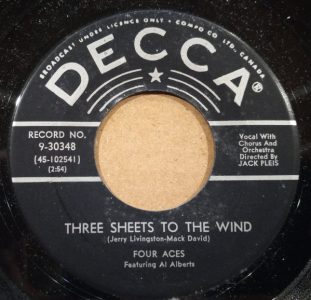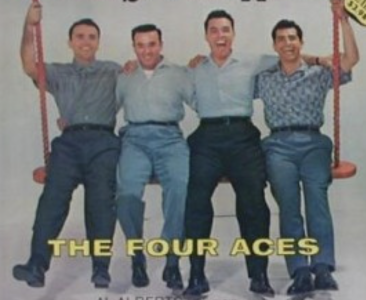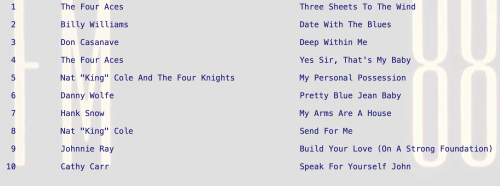#1: Three Sheets To The Wind by the Four Aces
City: Oshawa, ON
Radio Station: CKLB
Peak Month: July 1957
Peak Position in Oshawa ~ #1
Peak position in Vancouver ~ did not chart
Peak Position on Billboard Hot 100 ~ did not chart
YouTube: “Three Sheets To The Wind”
Lyrics: N/A
Al Albertini was born in Chester (PA) in 1922. In his childhood, young al appeared on a radio show from Philadelphia called The Horn and Hardart Children’s Hour. Horn and Hardart’s slogan was “Less work for mother dear whose gentle hands, lead us so kindly through little folk lands. We’ll give her happiness, each kindness, each caress repaid with thoughtfulness. Less work for mother dear.” After high school graduation in 1940, he was drafted into the United States Navy after the nation entered WWII in December 1941. While he was in the navy, Albertini met Dave Mahoney, and the pair discovered a mutual interest in singing and music. After WWII, they added Rosario “Sod” Vaccaro and Lou Silvestri to become a foursome. By the late 40s they were billed as The Four Aces. They released their first single, “Baby, wha hoppen”, in 1949.
When they recorded “(It’s No) Sin” in 1951, they couldn’t get a record company to record the song. So Al Albertini started Victoria Records and made a recording. The single soared to #4 on the Billboard pop chart, and spent 22 weeks on the survey. On the Cashbox Best Selling Singles chart, the song spent nine non-consecutive weeks at number-one, between November 3, 1951, and January 5, 1952. The song was also number-one for seven weeks on Your Hit Parade.
After the success of “(It’s No) Sin”, the Four Aces got signed with Decca Records. In early 1952, “Tell Me Why” peaked at #2 on the national pop charts in the USA. From January 19 to February 16, 1952, both songs were charting in the Top Ten on the Billboard and Cashbox pop singles charts. As well, in 1952, The Four Aces charted into the Top Ten with “Perfidia” and “Should I”, with “Heart And Soul” stalling at #11. in 1953, Decca Records had Al Alberts release a solo recording titled “Please Tell Me”, which got little attention beyond Philadelphia and Trenton (NJ).
In February 1954, “Stranger In Paradise” was released by Tony Bennett, the Four Aces and Tony Martin. The song spent two non-consecutive weeks at number-one on the Cashbox Best Selling Singles chart. It was also a #6 hit in England. Simultaneously, “That Gang That Sang ‘Heart Of My Heart’”, spent eleven non-consecutive weeks with “Stranger In Paradise” in the Top Ten in the USA between mid-December 1953 and March 1954. Later that year, “Three Coins In The Fountain” peaked at #1 in the USA and #5 in England. The song was ranked by Billboard magazine as the #8 song for the year 1954. In the fall of 1954, “It’s A Woman’s World” reached #11 on the Billboard pop singles chart.
In 1955, the Four Aces continued to chart successfully with a Top 5 cover of the Chordettes “Mr. Sandman” on Billboard, and a number-one Cashbox hit for six non-consecutive weeks in the winter of 1954-55. From January 8 to March 5, 1955, the Four Aces had both their version of “Mr. Sandman” and “Melody Of Love” in the Top Ten. The latter tune was a number-one hit on the Cashbox Best Selling Singles chart, sharing the position for seven weeks with both Billy Vaughan & Orchestra, and David Carroll & Orchestra.
In the fall of 1955, The Four Aces had another number-one hit in the USA with “Love Is A Many-Splendoured Thing”. The single peaked at #2 in England, #3 in Australia and #6 in Belgium. In the winter of 1955, “A Woman In Love” was recorded by the Four Aces. The song was from the musical Guys and Dolls. However, it stalled at #14 and was edged out of the Top Ten by the new sounds of pop, rock and R&B. Record buyers were snapping up copies of “At My Front Door” by the El Dorados; “Only You” by the Platters, and “I Hear You Knocking” – Gale Storm’s cover of the Smiley Lewis original; and “Daddy-O” a Fontaine Sisters cover of female rockabilly singer Bonnie Lou; Tennessee Ernie Ford’s “Sixteen Tons”; and the Four Lads “Moments To Remember”.
1956 was even more challenging for The Four Aces. Elvis Presley shook pop culture with his appearances on The Ed Sullivan Show, and his chart-topping hits “Heartbreak Hotel”, “I Want You, I Need You, I Love You”, “Hound Dog”, “Don’t Be Cruel” and “Love Me Tender”. And there was Carl Perkins singing “Blue Suede Shoes”, Jim Lowe with “Green Door”, Bill Doggett with “Honky Tonk Pt 2”, Frankie Lemon and The Teenagers with “Why Do Fools Fall In Love”, Bill Haley & His Comets with “See You Later Alligator”, Fats Domino, Little Richard, Gene Vincent, The Platters with “The Great Pretender” and “My Prayer”, the Cadets and more.
To be sure, traditional pop recording artists were still racking up solid record sales. Nelson Riddle, Gogi Grant, Morris Stoloff, Doris Day, Dean Martin, Kay Starr, Don Cherry, Patti Page, and Pat Boone, were all vying for the attention of the record-buying and jukebox playing audiences. But rock ‘n roll was on the ascendant. And The Four Aces were among the many recording acts that were being eclipsed with the new beat. The popular vocal quartet managed to have only one single barely crack the Top 20 in 1956, “You Can’t Run Away From It”.
In 1957, only one single release cracked the Billboard pop chart but didn’t reach the Top 50. Among the other singles released that year was “Yes Sir, That’s My Baby”, a cover of the 1925 pop standard which was a number-one hit for Gene Austin (and a #2 hit for Blossom Seeley). The B-side was a song titled “Three Sheets to the Wind”.

“Three Sheets to the Wind” is a song about a sailor who wants the winds to guide his boat back to his love (on the show). He bids the “west wind” to blow. When he last saw her before he sailed away, he said goodbye and kissed her. He believes she’s “somewhere beyond the horizon waiting for me.” For the moment, he’s sailing to his love. However, as we learn, being three sheets to the wind is a sign the boat is in trouble (or the sailor is himself drunk).
The phrase ‘three sheets to the wind’ is a nautical phrase. It first appeared in writing back in 1821 when Pierce Egan wrote in Real Life in London “Old Wax and Bristles is about three sheets in the wind.” Note that over the following decades “three sheets in the wind” became “three sheets to the wind.” The sheets aren’t sails, as landlubbers might expect, but ropes (or occasionally, chains). (They’re also not bedsheets). The ropes (sheets) are fixed to the lower corners of sails, to hold them in place. If three sheets are loose and blowing about in the wind then the sails will flap and the boat will lurch about like a drunken sailor.
Sailors at that time had a sliding scale of drunkenness; three sheets was the falling over stage; tipsy was just ‘one sheet in the wind’, or ‘a sheet in the wind’s eye’. An example appears in the novel The Fisher’s Daughter, by Catherine Ward, 1824: “Wolf replenished his glass at the request of Mr. Blust, who, instead of being one sheet in the wind, was likely to get to three before he took his departure.” In Robert Louis Stevenson’s Treasure Island, Long John Silver is given the line “Maybe you think we were all a sheet in the wind’s eye. But I’ll tell you I was sober. ”
1957 was the year of calypso, and though “Three Sheets To The Wind” isn’t a calypso song, there was a nautical theme in numbers of these songs. With the close harmony and confident lyrics, you’d have to wonder if the Four Aces knew the origin of the phrase they were singing about.
The song was co-written by Mack David and Jerry Livingston.
Mack David was born in 1912 to a Jewish family in New York City. He planned a career in law, but switched to songwriting as he tunes got attention. In 1935, Mack David had a Top 20 hit with “Quicker Than You Can Say Jack Robinson” for Ozzie Nelson and his Orchestra. In 1939, “Sixty Seconds Got Together” was a Top Ten hit for the Mills Brothers. That same year Glenn Miller had a number-one hit with Mack David’s “Moon Love” (which was also at Top Ten hit for several other recording artists).
Mack David’s other notable songs that went on to become hits include “On The Isle of May” (#3 for Connie Boswell in 1940), “The Singing Hills” (#2 for Bing Crosby in 1940), “Take Me” (#5 for Jimmy Dorsey in 1942), “Johnny Zero” (#7 for the Songs Spinners in 1943), “It’s Love-Love-Love Baby” (#1 in 1944 for Guy Lombardo and his Royal Canadians), “Candy” (a number-one hit for Johnny Mercer and Jo Stafford in 1945), “Chi-Baba, Chi-Baba” (number-one for Perry Como in 1946 – cowritten with Jerry Livingston), “Sunflower” (#5 for Russ Morgan in 1949), “Bibbidi-Bobbidi-Boo” (a Top 2o hit for both the Fontane Sisters and Jo Stafford in 1950), “I Don’t Care If the Sun Don’t Shine” (a #8 hit for Patti Page in 1950), “Cherry Pink and Apple Blossom White” (a number-one hit for Perez Prado in 1955), “Bimbombey” (#11 for Jimmy Rodgers in 1958), “Young Emotions” (#12 for Ricky Nelson in 1960 – cowritten with Jerry Livingston), “Baby It’s You” (#8 in 1961 for The Shirelles, and #5 for Smith in 1969), “Hush Hush Sweet Charlotte” (#8 in 1965 for Patti Page), and “It Must Be Him” (#3 in 1967 for Vicki Carr). In 1950, he also wrote (with Jerry Livingston) the theme song to the cartoon Casper the Friendly Ghost (which was featured in individual cartoon episodes before it got its own TV show beginning in 1959).
David’s most remunerative song was “Sunflower” recorded by Frank Sinatra in 1948. Jerry Herman used four bars from the song for his theme song in the hit musical Hello Dolly! When David sued Herman for copyright infringement, he won $250,000 in an out-of-court settlement. Mack David died on New Year’s Day in 1994 at the age of 81.
Jerry Livingston was born in Boulder, Colorado, in 1909. He moved to New York City in 1930 and began writing songs. His first hit record was in 1933 with “(When It’s) Darkness On the Delta” by the Ted Fio Rito and His Orchestra. That year Glen Gray & his Orchestra recorded two of Livingston’s songs, “It’s the Talk of the Town” and “Under a Blanket of Blue”, both which peaked at #6 in the USA. In 1934, “I’ve Got an Invitation to Dance” reached #8 for Paul Pendarvis & his Orchestra, while in 1938 the Mills Brothers took “Sixty Seconds got Together” also peaked at #8.
One of his biggest compositions was “Mairzy Doats”, a number-one hit in 1944 for the Merry Macks. The following year, Livingston had another number-one hit with “I’m A Big Girl Now” for Swing and Sway with Sammy Kaye. In 1954, “Wake The Town and Tell The People” was a Top Ten hit for Les Baxter and also for Mindy Carson. In 1957, Livingston co-wrote “The Twelfth Of Never”, a Top Ten hit for Johnny Mathis (and #1 hit for Donny Osmond in the UK in 1973). In 1959, he penned the TV theme song “77 Sunset Strip”. In the UK, Jerry Livingston provided hits for Barbara Lyon (“Stowaway” in 1955), and Ronnie Hilton (“Who Are We” in 1956).
With Mack David he was nominated on three occasions for Best Original Song at the Academy Awards. The first time was in 1951 for “Bibbidi-Bobbidi-Boo” from Cinderella. The second occasion was in 1959 for the theme song “The Hanging Tree” from the film of the same name. The third nomination was in 1966 for “The Ballad of Cat Ballou”, from the 1965 movie Cat Ballou.
In 1959, Jerry Livingston and Mack David wrote music for the private detective TV show Bourbon Street Beat. They also wrote music for the surf-detective TV show Surfside 6. In 1960, Jerry Livingston wrote “This Is It” for The Bugs Bunny Show. He also cowrote with Mack David music for the musicals Molly (1973) and Bright Lights of 1944 (1943). He died of a heart condition at age 78 in 1987.
“Three Sheets to the Wind” peaked at #1 in Oshawa (ON), #4 in Ottawa, and #10 in Greensboro (NC), and reached the Top 20 in Allentown (PA).

In 1958, The Four Aces managed a peak at #18 in the UK with “The World Outside”. However, Al Alberts left the quartet hoping for success as a solo artist. His first solo release since he left The Four Aces was “Things I Didn’t Say”.
After Al Alberts had left the group, Mahoney and Vaccaro also left. Silvestri never left the group but led three new members: Fred Diodati, Tony Alesi, and Joe Giglio. The Original Aces later asked Silvestri to rejoin the original group, and he did.
In 1969, Al Alberts became a television personality in Philadelphia. He hosted a one-hour Saturday afternoon talent show, Al Alberts Showcase, which first aired on WKBS-TV, and then on WPVI-TV. The show featured a panel of local children known as the “Teeny Boppers”. In addition, there was a group of young teenage dancers called the “Show Stoppers”. Local talents of all ages would sing songs and perform dance routines. A young Andrew Pica made his debut on the show. Andrew would later go on to be a frequent guest and showstopper. The show helped launch the careers of Andrea McArdle, Sister Sledge, The Kinleys, and Teddy Pendergrass.
After 32 years of broadcasting, the show went off the air with Alberts’ retirement in 2001. Al Alberts died in 2009 at the age of 87.
Before joining the Four Aces, David Mahoney served in the United States Navy during World War II. He was stationed as a clarinet player with a military band in Newfoundland. After he left the Four Aces Mahoney became owner of the David A. Mahoney Insurance Agency in Woodlyn, Delaware County (PA). He died in July 2012, of complications from Alzheimer’s disease at age 86.
Lou Silvestri (born 1926) worked as a court officer in the Delaware County Court House for 25 years. He competed all over the world in Skeet and trap shooting and also a member of the West Chester Gun Club and the Delaware County Field and Stream. He died in January 2013, at age 86.
Rosario “Sod” Vaccaro (born in 1922) was a veteran of World War II, during which he was both in combat and played in the Army Military Band. After 1987, when the original Four Aces retired, he opened up a pizza joint. He was later selected by the City of Chester to serve as Deputy Treasurer and Chief Deputy Tax Collector. He remained in that position as a consultant after his retirement. Vaccaro died in April 2013, at age 90.
August 11, 2025
Ray McGinnis
References:
“Al Alberts, Singer and TV Host, Is Dead at 87,” New York Times, November 27, 2009.
Al Alberts, “Fly Me To The Moon“, President Records, 1963.
Al Alberts, “High School“, Coral Records, 1959.
Walter Naedele, “David A. Mahoney, 86, 1950s Singer was one of the Four Aces” Philadelphia Inquirer, July 11, 2012.
“The Four Aces,” Vocal Group Hall of Fame, 2001.
“Louis Silvestri Obituary,” Legacy.com, January 29, 2013.
“Rosario Vaccaro Obituary,” Delco Times, Chester (PA), April 11, 2013.
“Mack David, 81, A Composer and Lyricist,” New York Times, January 1, 1994.
“Jerry Livingston Dies, Wrote ‘Mairzy Doats’,” New York Times, July 10, 1987.
Gary Martin, “Three Sheets To The Wind,” phrases.org.uk.

CKLB 1350-AM Oshawa (ON) Top Ten | July 20, 1957

Leave a Reply